Yankun Zhen
Fragmented Layer Grouping in GUI Designs Through Graph Learning Based on Multimodal Information
Dec 07, 2024



Abstract:Automatically constructing GUI groups of different granularities constitutes a critical intelligent step towards automating GUI design and implementation tasks. Specifically, in the industrial GUI-to-code process, fragmented layers may decrease the readability and maintainability of generated code, which can be alleviated by grouping semantically consistent fragmented layers in the design prototypes. This study aims to propose a graph-learning-based approach to tackle the fragmented layer grouping problem according to multi-modal information in design prototypes. Our graph learning module consists of self-attention and graph neural network modules. By taking the multimodal fused representation of GUI layers as input, we innovatively group fragmented layers by classifying GUI layers and regressing the bounding boxes of the corresponding GUI components simultaneously. Experiments on two real-world datasets demonstrate that our model achieves state-of-the-art performance. A further user study is also conducted to validate that our approach can assist an intelligent downstream tool in generating more maintainable and readable front-end code.
EGFE: End-to-end Grouping of Fragmented Elements in UI Designs with Multimodal Learning
Sep 18, 2023Abstract:When translating UI design prototypes to code in industry, automatically generating code from design prototypes can expedite the development of applications and GUI iterations. However, in design prototypes without strict design specifications, UI components may be composed of fragmented elements. Grouping these fragmented elements can greatly improve the readability and maintainability of the generated code. Current methods employ a two-stage strategy that introduces hand-crafted rules to group fragmented elements. Unfortunately, the performance of these methods is not satisfying due to visually overlapped and tiny UI elements. In this study, we propose EGFE, a novel method for automatically End-to-end Grouping Fragmented Elements via UI sequence prediction. To facilitate the UI understanding, we innovatively construct a Transformer encoder to model the relationship between the UI elements with multi-modal representation learning. The evaluation on a dataset of 4606 UI prototypes collected from professional UI designers shows that our method outperforms the state-of-the-art baselines in the precision (by 29.75\%), recall (by 31.07\%), and F1-score (by 30.39\%) at edit distance threshold of 4. In addition, we conduct an empirical study to assess the improvement of the generated front-end code. The results demonstrate the effectiveness of our method on a real software engineering application. Our end-to-end fragmented elements grouping method creates opportunities for improving UI-related software engineering tasks.
Incorporating Domain Knowledge through Task Augmentation for Front-End JavaScript Code Generation
Aug 23, 2022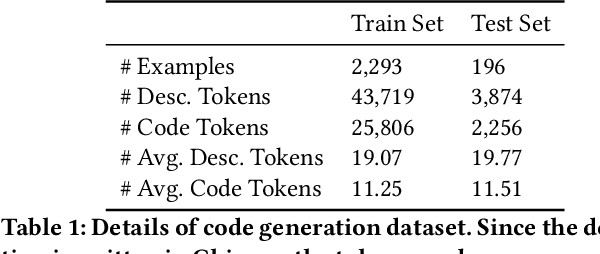
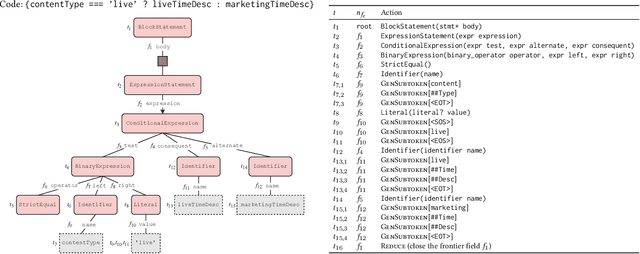
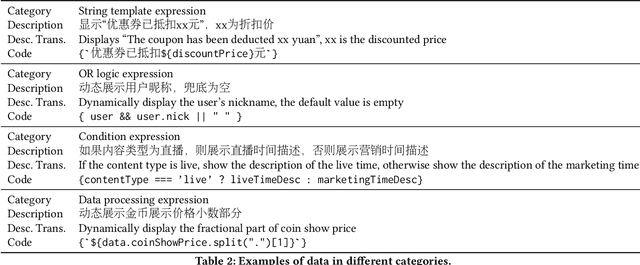

Abstract:Code generation aims to generate a code snippet automatically from natural language descriptions. Generally, the mainstream code generation methods rely on a large amount of paired training data, including both the natural language description and the code. However, in some domain-specific scenarios, building such a large paired corpus for code generation is difficult because there is no directly available pairing data, and a lot of effort is required to manually write the code descriptions to construct a high-quality training dataset. Due to the limited training data, the generation model cannot be well trained and is likely to be overfitting, making the model's performance unsatisfactory for real-world use. To this end, in this paper, we propose a task augmentation method that incorporates domain knowledge into code generation models through auxiliary tasks and a Subtoken-TranX model by extending the original TranX model to support subtoken-level code generation. To verify our proposed approach, we collect a real-world code generation dataset and conduct experiments on it. Our experimental results demonstrate that the subtoken-level TranX model outperforms the original TranX model and the Transformer model on our dataset, and the exact match accuracy of Subtoken-TranX improves significantly by 12.75% with the help of our task augmentation method. The model performance on several code categories has satisfied the requirements for application in industrial systems. Our proposed approach has been adopted by Alibaba's BizCook platform. To the best of our knowledge, this is the first domain code generation system adopted in industrial development environments.
ULDGNN: A Fragmented UI Layer Detector Based on Graph Neural Networks
Aug 13, 2022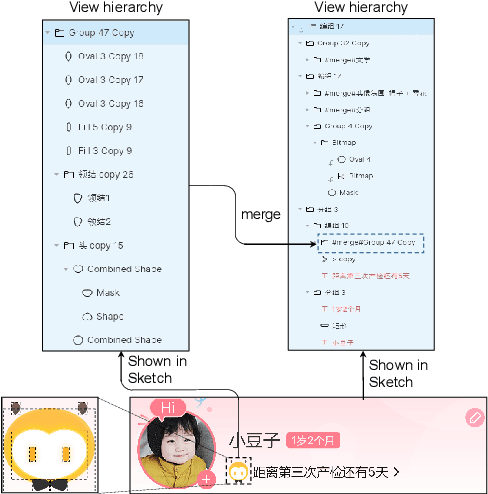

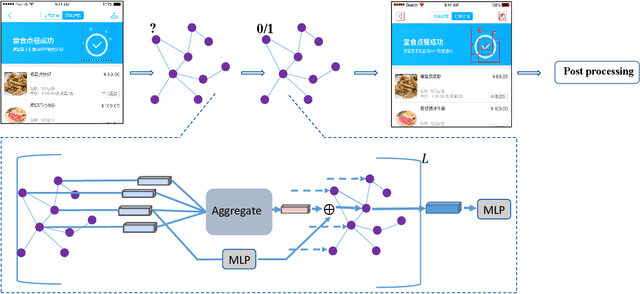

Abstract:While some work attempt to generate front-end code intelligently from UI screenshots, it may be more convenient to utilize UI design drafts in Sketch which is a popular UI design software, because we can access multimodal UI information directly such as layers type, position, size, and visual images. However, fragmented layers could degrade the code quality without being merged into a whole part if all of them are involved in the code generation. In this paper, we propose a pipeline to merge fragmented layers automatically. We first construct a graph representation for the layer tree of a UI draft and detect all fragmented layers based on the visual features and graph neural networks. Then a rule-based algorithm is designed to merge fragmented layers. Through experiments on a newly constructed dataset, our approach can retrieve most fragmented layers in UI design drafts, and achieve 87% accuracy in the detection task, and the post-processing algorithm is developed to cluster associative layers under simple and general circumstances.
 Add to Chrome
Add to Chrome Add to Firefox
Add to Firefox Add to Edge
Add to Edge